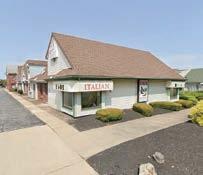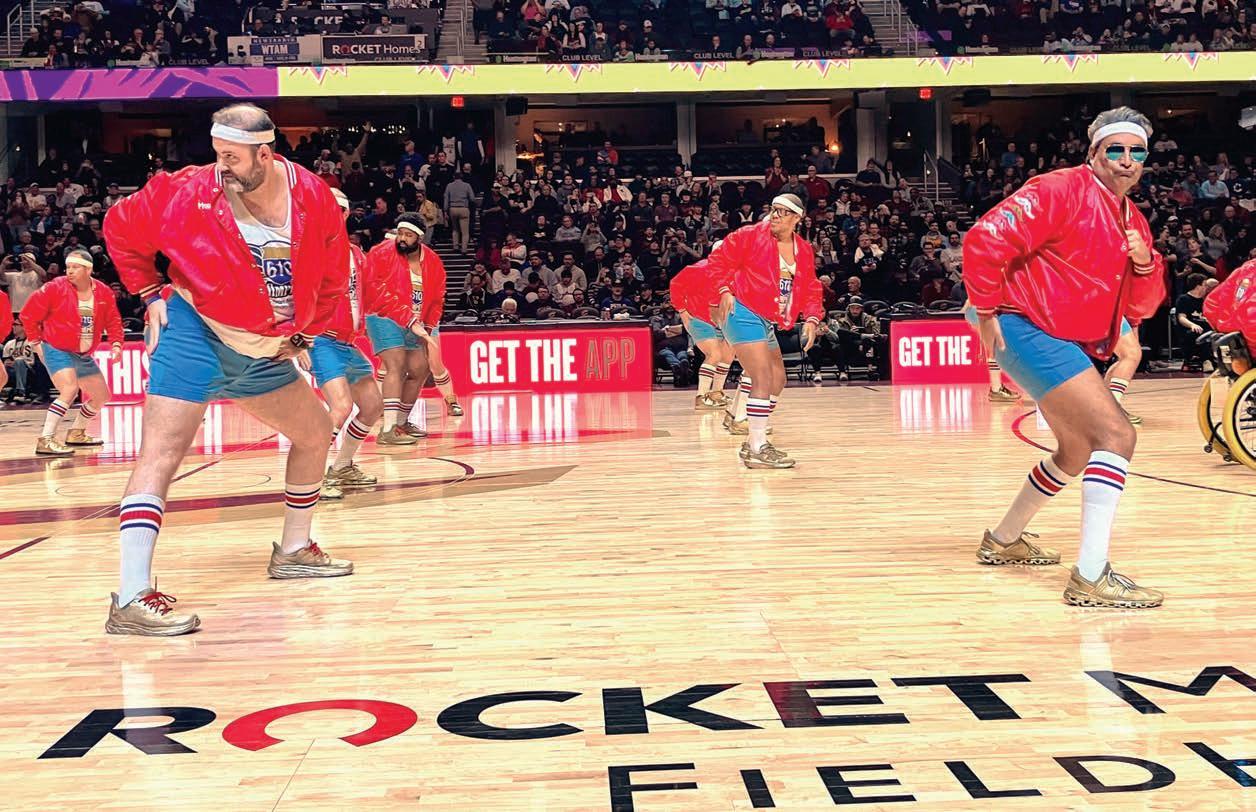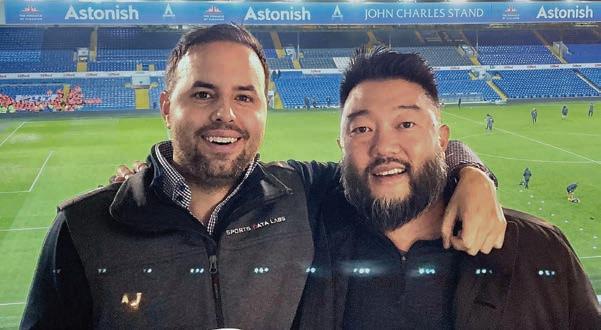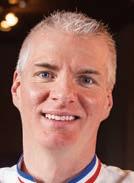PATH CLEARED FOR PARK
Port of Cleveland board OKs Irishtown Bend legal settlement with Bobby, Tony George
 BY KIM PALMER AND MICHELLE JARBOE
BY KIM PALMER AND MICHELLE JARBOE
e Cleveland-Cuyahoga County Port Authority’s board of directors has signed o on a legal settlement that clears the way for stabilization of the Irishtown Bend
hillside and the eventual creation of a 23-acre riverfront park.
In a unanimous vote on Tuesday, March 28, the agency’s board authorized a deal between a slew of civic partners and father-andson real estate investors Tony and Bobby George, who own the last
piece of property needed for the hillside work.
e settlement, which still requires approval from the board of park commissioners for the Cleveland Metroparks, will end a stalled eminent domain proceeding and a tortuous legal ght. e
Makeover coming to FirstEnergy Stadium
Haslams leaning toward renovating, not replacing
BY JOE SCALZO
When it comes to FirstEnergy Stadium, Cleveland Browns owners Jimmy and Dee Haslam said they’re looking for a makeover, not a do-over.
Speaking to local reporters at the NFL owners meetings in Phoenix, the Haslams said the Browns are leaning toward renovating the stadi-
um as part of a larger plan to develop the lakefront. e stadium’s 30year lease expires at the end of 2028 and there have been reports that the Haslams preferred replacing FirstEnergy with a domed stadium further inland.
“Cleveland would bene t tremendously from the development of the waterfront,” Jimmy Haslam
said on Monday, March 27. “Having the stadium down there seems to be in everybody’s best interest. So we’re committed to redoing the stadium. In all likelihood, it’s not going to have a dome, but it’ll be a substantial remodel of the existing facility and we’re probably three, four, ve years away from that happening.”
See STADIUM on Page 17
SPORTS BUSINESS
From breathtaking to butt-shaking:
How NBA teams choose halftime acts.
PAGE 12
park district’s board has scheduled a special meeting on Tuesday, April 4, to vote on the proposal. e port is aiming for a summer construction start on the $55 million-plus stabilization project, which involves regrading the hill
and installing bulkheads at the river’s edge.
e other partners on the project are the city of Cleveland, neighborhood nonpro t Ohio City Inc., LAND Studio and West Creek

See SETTLEMENT on Page 18
CWRU program to explore legalities of athlete data
BY JEREMY NOBILE
From how fast a heart beats to uctuating levels of cortisol, who exactly owns the real-time data collected on athletes while they perform? And what are the legalities around capturing, processing and monetizing that information?
ose are some of the novel questions the newly formed Athlete Data Lab (ADL) at the Case Western Reserve University School of Law is looking to answer.
e CWRU lab is being launched in partnership with Sports Data Labs

See CWRU on Page 16
GOVERNMENT
U.S. Black Chambers Inc. honors Downtown

Cleveland Alliance leader

Heather Holmes Dillard.
PAGE 8
VOL. 44, NO. 13 l COPYRIGHT 2023 CRAIN COMMUNICATIONS INC. l ALL RIGHTS RESERVED NEWSPAPER CRAINSCLEVELAND.COM I APRIL 3, 2023
An aerial rendering shows the planned 23-acre Irishtown Bend Park in Cleveland’s Ohio City neighborhood. | PLURAL
Silver Hills Development oats 200-unit apartment complex in city of Lorain
BY STAN BULLARD
Continuing a penchant for property projects with water views, Silver Hills Development of Beachwood wants to build a 200-unit apartment complex on the west side of Lorain.

e complex would include a 169unit, four- oor apartment building and six smaller two-story buildings with a total of 36 suites. e 4-acre site on the northwest side of the intersection of Kolbe Road and U.S. 6 is separated from the lakefront by Norfolk Southern railroad tracks.
e buildings would incorporate parking below the structures so they would be tall enough to o er lake views. e city of Lorain gave the project approval for a preliminary plan.
e other Silver Hills water-view project is in the Cleveland Flats. In a partnership with Edwards Communities of Columbus, Silver Hills is starting to build a 300-suite apartment complex overlooking the Cuyahoga River on Carter Road. at project is on Scranton Peninsula.
Lorain City Councilman Joshua ornsberry, who represents Ward 8 (which includes the site), said the proposal has received criticism from a single resident, so he expects little opposition so far.
“If it were going to be contested, we would have already seen dozens of residents at meetings,” ornsberry said. He said the proposed complex, with a pool, lobby-area workfrom-home rooms and other
features, appears to be designed to serve young professionals in the city.
“I’m not sure how that will work in Lorain,” ornsberry added. However, he noted elevators in the larger building could attract older people, because recently completed senior citizen apartments in Lorain have been leasing well.
e councilman said it’s too early for him to voice his position on the proposed development. Besides nal approval, he said, the developer needs several variances. e most signi cant of those is a height variance.
e most recent market-rate apartment complex in Lorain County dates from 2016, according to CoStar, the online real estate data provider. CoStar reports six apartment communities in the county that it classes as four out of a possible ve stars (reecting both quality and age) with rents above $1,000 monthly.
Vacancy in those properties is less than 1% in each of them. Overall, the county has a vacancy of 4.4%, CoStar estimates.
Lorain County land records show the current owner of the site is a trust based in Bellevue, Washington. e proposed project is 3 miles west of downtown Lorain and 28 miles west of Public Square in downtown Cleveland.
Seth Mendelsohn, a principal at Silver Hills, did not return a phone call, an email message and a message through the LinkedIn website by 5 p.m. Tuesday, March 28.
Developer sells Cleveland pet hospital for $18 million
MedVet, the Columbus-based chain of emergency veterinary practices, moved last month into a new round-the-clock emergency clinic in western Cleveland that its build-tosuit developer just sold for $18 million to Realty Income Corp. (NYSE: 0.) of San Diego.
e transaction for the 35,000-square-foot pet emergency clinic and specialty center, consummated within a month of MedVet occupying the new property Feb. 20, is a recent example of merchant builder developers at work in Cleveland. Such builders and developers build to sell rather than retain properties for their own portfolio.
Banking vet Dostal joins ranks of independent loan brokers
STAN BULLARD
In the banking world, Michael Dostal has just taken the lender’s version of a walk on the wild side.
After almost 30 years in commercial real estate lending with four different banks (though some changes came through mergers), Dostal has just entered the commercial real estate mortgage brokerage and loan servicing business as an associate at the Independence o ce of District Capital.

Commercial real estate loan brokers swap the stability of a bank’s steady paycheck for potentially larger earnings for nding loans for property owners and developers. And of course, the downtimes that go with that as well.
same, which will make (Dostal) a real asset for District,” Leonard said. “While (Walter) and I have followed our clients out of town to make deals, Dostal knows more people outside of Cleveland than we do.”
Dostal also is landing at District Capital at the relative ground oor.
Although District Capital is based in Detroit, it was just launched as a larger rm geographically in January 2023.
ways thought that when things get tough, the value of mortgage brokers is more profound.”
Dean Razek is president of the Greater Cleveland Mortgage Bankers Association, a trade group that provides professional development opportunities for lenders on both the lender and borrower side of the table.
MGB Development, which has ofces in Southlake, Texas, and Savannah, Georgia, built the pet property at 20400 Emerald Parkway and through Health Care I LLC sold it to an a liate of Realty Income.
Sarah Berger, a spokesperson for MedVet, said in a phone interview
that the company uses a variety of techniques to construct properties through owning them or leasing them depending on the best way to deploy its capital at any given time.
“We’re thrilled with the new property,” she said. “It’s a much larger facility than we had previously and will allow our practice to grow. We have three additional specialists that are joining this location.” Previously, MedVet was in a smaller building, also near I-480, in Brook Park.
In the case of Realty Income, veterinary practices are a natural expansion area for the company, which has recently acquired casinos and dental practices beyond the traditional freestanding restaurant or other retail business. Its website said it owns 12,200 properties.
MGB Development’s website does not disclose the company’s size, although it builds for medical, hotel, o ce and industrial properties. However, a map shows it had built properties across the country from Massachusetts to Oregon. e Cleveland property it just sold was its second in Ohio, according to the map.
Stan Bullard: sbullard@crain.com, (216) 771-5228, @CrainRltywriter
In Dostal’s case, he left a post as managing director and commercial real estate regional manager for Ohio with CIBC U.S. e U.S. operation is part of Toronto-based CIBC, which stands for Canadian Imperial Bank Corp.
Dostal, in an interview with local District Capital principals Jim Leonard and Brock Walter, said he left commercial banking for several reasons of his own.
“I wanted a more exible approach to the workday,” Dostal said. “I want to spend more time on nonpro t boards and spend more time on my personal real estate. ese are exciting times in banking. I hope to contribute to District Capital and have an impact on the region.”
His CIBC unit closed $1 billion in commercial loans over the last six years. CIBC commercial real estate loan sta ers continue to work in the region, though a successor has not been named.
Leonard, a District Capital managing director, said Dostal brings to District skills in underwriting from the lender’s side and knows more about the nance industry than most newcomers.
“ e core competencies are the
District Capital was formed by the combination of three previously independent commercial real estate mortgage companies. ose included the District Capital rm in Detroit, Crossroads Real Estate Advisors in Indianapolis and Westwood Real Estate Capital in Cleveland, Leonard and Walter’s predecessor rm. e rms decided they could make a larger contribution together by leveraging their varied lender, customer and industry contacts.
In the wake of two large bank failures, skyrocketing interest rates as the Fed hikes rates to combat ination and tightening credit terms because lenders are growing more cautious, it might seem an odd time to go freelance.
Walter and Leonard said they cannot disagree more. When they formed their rst mortgage brokerage company in 1990, commercial mortgage interest rates were 12%, while now they’re 7%.
“ at was a heck of a lot harder than it is now,” Walter said. Many borrowers are also disappointed when they re nance commercial properties now than just a few years back, because higher equity requirements mean they can take less out in a re .
“We think this is the time to gain market share,” Leonard said. “Not everyone’s go-to bank is as active as it might have been. is is a great time to talk about re nancing construction loans with people who weren’t open to it before. We’ve al-
“I’ve always seen it as a di erence in stability for the individual,” Razek said in a phone interview. “As a bank lender, you aren’t going to everyone to see how to get the best loan for your customer.”
Razek also noted mortgage brokers are able to co-invest with their clients, which bank brokers are not permitted to do. He said some life insurers are not only making permanent loans but construction loans, something they have not done for years. Firms such as District have those insurer relationships.
“It’s more of a sales position,” Razek said. “You’re competing with a handful of companies in that space.”
Making shifts when the world changes is part of Dostal’s background. Before going into banking, he worked in underwriting and lending as an economic development sta er for the city of Cleveland and later served as executive director and commercial real estate manager for the Ohio City Inc. community development corporation. He remains active in Ohio City and looks forward to chairing the property owners board for the Ohio City Special Improvement District in the future.
Dostal joins a sta of three other producers and a full-time sta of six at District Capital.
Leonard said District Capital established its o ce on Rockside Road with the inception of the company at the beginning of the year.
“We have an open design, a roaming desk system,” Leonard said. “We needed an o ce so there would be a place to train people new to the business.”
2 CRAIN’S CLEVELAND BUSINESS | AP RIL 3, 2023
REAL ESTATE STAN
BULLARD
“IT’S A MUCH LARGER FACILITY THAN WE HAD PREVIOUSLY AND WILL ALLOW OUR PRACTICE TO GROW.”
—Sarah Berger, a spokesperson for MedVet
Banking vet Michael Dostal’s expertise can help with construction of real estate developments such as these apartments near Edgewater Beach in Cleveland, which rely on multiple disciplines. | STAN BULLARD/CRAIN’S CLEVELAND BUSINESS
Dostal

University of Akron Research Foundation is cultivating leaders for startup economy

 BY DAN SHINGLER
BY DAN SHINGLER
ey’re training more than lawyers at the University of Akron School of Law — and, as a result, the school’s research foundation is doing more than supporting professors with potential startups.
e school and the University of Akron Research Foundation (UARF) have formed a symbiotic relationship that is creating leaders for Northeast Ohio’s startup economy, with alumni now running not only the foundation, but other major organizations supporting startups in Northeast Ohio and beyond.

ere’s Jessica Sublett, trained at the Akron law school, who, instead of becoming a lawyer in the traditional sense, became a program specialist at the Akron Global Business Accelerator. As of this year, she’s president and CEO of the Akron business incubator Bounce Innovation Hub, a behemoth 300,000-square-foot business landlord and support agency in downtown Akron.
Dan Hampu, also an Akron law school grad, went on to work with several startups in town and to run the Northeast Ohio Student Venture Fund, which trains students from multiple universities in the analysis of companies and investments. Last summer, he was named president and CEO of the Burton D. Morgan Foundation in Hudson, one of (if not the largest) grant-writing entities in Northeast Ohio that specically supports area entrepreneurs.
Elyse Ball is yet another trained attorney from the UA law school. She’s also put her legal chops to work on behalf of entrepreneurs and others who support startups. She now runs UARF as executive director and works closely with the National Science Foundation’s I-Corps program in Akron, training entrepreneurs to de ne and analyze their markets as a means of guiding their product development e orts.
Further north is Joseph Rich — he’s senior innovations o cer of new ventures at Cleveland Clinic. He’s another U of A lawyer, one also with an MBA from the school.

And nally, with Southern and national prominence, there’s Andrew Maas. He’s vice president for Research in Innovation & Ecosystem Development at Louisiana State University and incoming board chair for the Association of University Technology Managers, which consists of school-related technical transfer professionals from around the country.
e cadre of leaders the program has developed say UARF was fundamental to their becoming startup and entrepreneurial experts, not to mention a source of what are proving to be lifelong connections among one another and others who have been involved with the foundation and its work.
ey’re also showing how a law degree doesn’t have to result in a career as an attorney to be valuable. Many of the law students who go to work with UARF never intended to practice law but knew that a deep understanding of contracts, intellectual property rights, non-disclosure agreements and other legal
documents would be invaluable in other elds.
“One thing I knew (in law school) — and this is nothing against the legal profession or the law school — but I knew I didn’t want to practice law,” Hampu said. “I was interested in management consulting and how to help support a university.”
Ball worked for UARF before she went to law school, but she came back, bitten by the startup bug and seemingly infected for life.
“I actually worked there for a year before I went to law school,” Ball said. “ en when I was done with law school, I thought, ‘At UARF, that was the most fun I ever had.’”


Sublett has similarly fond memories, she said. And, like a true startup geek, she reminisces about things like I-Corps’ “Lean Canvas” philosophy of simple, to-the-point, one-page business plans.





“ ey just turned us loose,” Sublett recalls. “ at was the time when UARF was just launching I-Corps. We were all drinking in the Lean Canvas mentality, and it really framed who we were.”
At the heart of the foundation in recent years have been two senior fellows that the alumni all speak of today with a mix of reverence, admiration, a ection and, occasionally, bemusement.
ose would be Gordon Schorr and Barry Rosenbaum, two former chemical engineers and corporate executives who have devoted themselves to the success of the foundation and its student interns.
Maas recalls when he rst got to UARF in 2010, he ignored the advice of some others and got to know Schorr and Rosenbaum very well, especially Rosenbaum.
“I was warned when I took on the job that I should avoid Barry and Gordon,” Maas said with a chuckle. “I said, ‘No, they seem to have their crap together.’ So, I spent a lot of time with them.”
It was a good decision, he said, and he got an excellent post-law school education in how startups work and what entrepreneurs need to succeed — and what it takes to run an agency supporting both.
“I got a grant-writing education, a commercialization education, intellectual-property education — by my last year there, I had been instrumental in winning $4 million to $5 million in grants and support for UARF or UARF-a liated startups,” Maas said. “When I moved down to LSU, I just turned that on here as well, and people were like, ‘How did you learn to do all this stu ?’”
Rosenbaum and Schorr say they’ve had a blast teaching younger folks some of what they’ve learned over the course of their careers. It’s what UARF was hoping to achieve when it instituted its senior fellow program in 2005, they said.
“I think it was all about having fun,” Schorr said. “Let’s take graduate students and train them to become entrepreneurial leaders in our community … part of that is to create an environment in which young students and retired corporate guys can all work together.”
ey’ve recently been heartened to see that aspect of UARF expand as some other executives retired during the pandemic but found they didn’t want to stop working entirely.














“Gordon and I have been doing this for 18 years. But recently, the senior fellow community at UARF has expanded to six or seven people,” Rosenbaum said. “ e senior fellow concept, which Gordon started in 2005, has helped develop not just technologies and commercialization, but it’s helped developed people over a long period of time.”
ey also say the foundation’s impact should show people the value of not only economic development e orts in tech transfer, but the value of having a strong local university steeped in new technologies.



Now the challenge might be to keep the momentum going. at will require not just the new senior fellows, but continued participation from students.
ere’s apparently still plenty of interest in UARF among students at the law school, though.
Second-year law school student Julia Meyers said she’s been working at UARF for nearly a year and has already gotten some great hands-on experience working with companies supported by the foundation.
“I’ll go over agreements, whether they’re licensing agreements or operating agreements,” Meyers said.

She also leads the foundation’s Spark Fund, which provides funding, advisory services and other support to professors and others working to commercialize technology from the University of Akron.
“I want to do intellectual-property law. So, I thought UARF would be a good place to start, because they overlap with IP — and getting to know the business side of things will be bene cial to me as an attorney in general.”
Dan Shingler: dshingler@crain.com, (216) 771-5290





















4 CRAIN’S CLEVELAND BUSINESS | APRIL 3, 2023 APPLEGROWTH.COM/CAREERS WANT BALANCE WITHOUT THE ACT? LOOKING FOR YOUR OWN HEALTHY CAREER GROWTH? FIND A MODERN WORKPLACE THAT WORKS FOR YOU LIVE REAL ESTATE AUCTION - APRIL 27 NE OH COMMERCIAL/OFFICE/INDUSTRIAL LAND FOR BROCHURE & TERMS CALL MIKE BERLAND 216.861.7200 HANNA COMMERCIAL • CHARTWELL AUCTIONS • MICHAEL BERLAND, AARE, OH AUCTIONEER CHARTWELLAUCTIONS.COM 1.2 ACRE INDUSTRIAL DEVELOPMENT SITE 21851 CENTER RIDGE, ROCKY RIVER, OH 3,850 SF PROFESSIONAL OFFICE CONDO APPROXIMATELY 4,000 SF COMMERCIAL CONDO BUILDING COMPRISED OF 6 UNITS Located in the heart of Rocky River, this unit was a former Medical Practice. Ideal for any type of office use. Open Houses: Wednesdays, April 5, 12, & 19, 1-3 p.m. This building is comprised of 6 units from 560 SF to 760 SF each. Ideal for a variety of possible uses including retail, restaurant, office, etc. Open Houses: Thursdays, April 6, 13, & 20, 1-3 p.m. Located in Middleburg Heights with close proximity to Cleveland Hopkins Airport, I-71, I-77, and I-480. PUBLISHED RESERVE PRICE: $25,000 PUBLISHED RESERVE PRICE: $275,000 PUBLISHED RESERVE PRICE: $75,000 5360 OBERLIN, LORAIN, OH SHELDON RD., MIDDLEBURG HEIGHTS, OH Providing Commercial Real Estate Loans Throughout Northeast Ohio and 15 Other States GET YOUR EGGS IN THE RIGHT BASKET WITH A LOAN FROM CBS STRAIGHT TALK. SMART DEALS® CONTACT JONATHAN A. MOKRI 440.526.8700 jmokri@cbscuso.com www.cbscuso.com Personalized Service Loans up to $30 Million • No Prepayment Penalties Investment & Owner-Occupied Commercial Real Estate AKRON
University of Akron Research Foundation Senior Fellow Barry Rosenbaum with law school students Jessica Sublett, Dan Hampu and Andrew Maas when all worked together at the foundation. | CONTRIBUTED
‘Guardians Live’ host on Bally Sports future: ‘We know as much as you do’
 BY JOE SCALZO
BY JOE SCALZO
When it comes to Cleveland’s baseball team, “Guardians Live” host Jensen Lewis is happy to predict the future.

As for the company that broadcasts its games? Not so much.
Lewis, who co-hosts “Guardians Live” with Al Pawlowski on Bally Sports Great Lakes, admitted he’s not sure what will happen with Bally Sports following last month’s bankruptcy ling by its parent company, Diamond Sports Group.
“For those who are going to be watching Guardians baseball this year, I’ll go ahead and get this out of the way: We know as much as you do,” he said at a Pro Football Hall of Fame Luncheon Club meeting in Canton on Monday, March 27. “All I can tell you is ursday night at 9:30, turn that dial to Bally Sports Great Lakes (for the season opener). Al and I will be with you. Matt (Underwood), Rick (Manning) and Andre (Knott) will be on the call.
“Until you hear any di erently, just keep doing it. I have no other information for you outside of that.”
Bally Sports owns the broadcasting rights to 14 major league teams, including the Guardians. Diamond is reportedly trying to get out of the agreements with four of them — the Guardians, Cincinnati Reds, Arizona Diamondbacks and San Diego Padres — on the grounds that they cost the company more in rights fees than they generate in cable contracts and ad revenues. MLB has vowed to broadcast those teams’ games this summer if Diamond follows through with those plans.
Bally Sports Great Lakes announced its broadcasting plans for Guardians game on March 23 and the news release made no mention of the bankruptcy proceedings, or any changes in how fans can watch the games. Lewis said the network hasn’t said anything di erent to the on-air talent either.
“We’re in the same boat as you guys,” he said. “We’ll see where it all ends up.”

Lewis, who turns 39 in May, spent four seasons (2007-10) as a relief pitcher for the Indians and is entering his 11th year as a Cleveland baseball broadcaster. He weighed in on Cleveland’s name change, baseball’s rule changes, the Guardians’ prospects for 2023 and more.
Here are four other takeaways from his speech:
The city name is more important than the team name.
Lewis grew up in Medina cheering for the Indians and was drafted twice by the Tribe, rst in 2002 out of Cincinnati Anderson High School and again in 2005 out of Vanderbilt. So when he was asked about the Indians changing to Guardians in 2022 — while teams like the Kansas City Chiefs and Atlanta Braves have not — he spoke as someone who understands the fans’ connection to the name.
“I was a Cleveland Indian — al-


ways will be — and I was so very proud to have worn that uniform,” he said. “ at’s who I’ll always be. I’ll never be a former Cleveland Guardians pitcher. I’m a former Cleveland Indians pitcher. … I know that I enjoyed being a Cleveland Indian. at’s all I ever wanted to be.”
But …
“Now that I cover the team as the Cleveland Guardians, it’s still the Cleveland baseball organization that means the most to me,” he said. “If you come out to the parade when we win a world championship as the Cleveland Guardians, to me it (won’t) be any di erent than if the Cleveland Spiders were the team. at’s the most important point. If we win a championship, that’s all that’s going to matter.”
MLB’s rule changes are going to make the game better.
Major League Baseball made several rule changes in the o season to speed up the game and increase the action, including instituting a pitch clock, banning the in eld shift and making the bases bigger.
e changes are expected to cut about 25 minutes of dead time from each game, while increasing stolen base attempts and scoring.
“I think you’ll nd that when you have guys that are locked in a little more, when you have more action, it’s going to produce a better product,” said Lewis, who said the pitch clock wouldn’t have a ected him as a pitcher since he liked to work quickly. “In talking to guys already — and not just our group, but guys around the league — this is pretty big for these guys. I think they feel their games have gone to another level, and we may see even more positive results from it.
“So for those who haven’t gotten around to it (watching spring training), it’ll take some more time. But I promise you, you’ll be ne with 2½ hour games.”
Extending Jose Ramirez was a franchise-changer.
Many people in the Guardians organization believe last year’s surprising run to the AL Central Division crown was due in large part to Jose Ramirez’s decision last April to sign a below-market contract to stay in Cleveland.
e contract was for seven years and $141 million. Lewis believes Ramirez could have gotten between $250 million and $300 million on the open market.
“ at was the turning point for me all of last year, and it may end up being the turning point for this franchise moving forward,” Lewis said. “He said, ‘I’m happy, I love it here and I want to build here and I want to win a title here.’ ere’s no better ringing endorsement than for a superstar player, a top-10 player, to say, ‘Cleveland is home and you all need to come play with me here because it’s a great place to play.’”
Lewis expects the Guardians to lock up several more young players,
especially now that David Blitzer has purchased a minority stake in the team. Team owner Paul Dolan has said Blitzer’s addition won’t cure Cleveland’s payroll gap with MLB’s biggest spenders, but it could make it easier to lock up young players.
“I think for the body of work of what our front o ce has done, it wouldn’t shock me if you see throughout this season continued conversations with our young people to try to get them under contract,” Lewis said. “You’ve got to remember, we don’t have a ton of payroll committed beyond next year outside of Jose and some arbitration-type deals. So we’ll have money to spend, and I think they’ll be pretty aggressive with it.”
Ramirez, rst baseman Josh Bell, center elder Myles Straw and closer Emmanuel Clase are the only four players under contract for next season, and Bell’s contract is a player option. e biggest question mark is ace
Pay, Perks
pitcher Shane Bieber, who will make $10 million this season and is still under team control next year. e two sides have not made much progress about a long-term extension.
“We’re not too far removed from the (former Indians GM) John Hart model of locking up your young talent in the ’90s and it was pretty good after that,” he said. “I think it’s going to be maybe a cascading e ect here of, is it (in elder Andres) Gimenez? Is it (out elder Steven) Kwan? ey’re possibly having discussions with (shortstop) Amed (Rosario) about it. Of course you know about Shane. I think a lot is predicted on how they start this season.”
The Guardians aren’t a safe bet to win the World Series — but they’re not a bad bet, either.
e Guardians are favored (+135) to win the AL Central but have the 12thbest odds (+2200) to win the World Series.
While Lewis is predicting the Toronto Blue Jays will win the American League pennant, he believes the Guardians are capable of making a surprise championship run — and making a nice pro t for any Ohioans interested in sports betting.
Especially if bettors can nd an app willing to give 30-to-1 odds on the Guardians winning the World Series.
“We are now in a legal wagering jurisdiction here in the state of Ohio, so I can talk about this,” he said, drawing laughter. “If it’s above 30-to-1, take some pizza money and put it on it. See what happens.”
Regardless of what happens in October, Lewis believes the Guardians will once again be very credible contenders between April and September.
“Our team is damn good,” he said. “Last year was not a uke.”
Joe Scalzo: joe.scalzo@crain.com, (216) 771-5256, @JoeScalzo0


This informative program on executive compensation combines perspectives from the legal and financial planning disciplines to give you the tools you need to make an informed transition and understand how to negotiate the best package.



APRIL 3, 2023 | CRAIN’S CLEVELAND BUSINESS 5 FAIR PORT WEALTH FAIR PORT FAIR PORT WEALTH FA FAIR PORT WEALTH
REGISTER TODAY CRAINSCLEVELAND.COM/PAY-PERKS FREE WEBINAR THURSDAY, APRIL 27
12PM
to
EMILY SHACKLETT, CPA Director and Wealth Advisor Fairport Wealth AMY ANN STOESSEL Associate Publisher Crain’s Cleveland Business
& Parachutes
|
When considering a change in career, it’s vital
look before you leap.
SPEAKERS: POWERED BY: PRESENTED BY: ANN-MARIE AHERN Principal and Employment Practice Group Leader McCarthy Lebit Crystal Liffman
CRAIN’S CONTENT STUDIO
SPORTS BUSINESS
Former Indians pitcher Jensen Lewis, left, and Al Pawlowski host “Guardians Live” on Bally Sports Great Lakes. | BALLY SPORTS GREAT LAKES
Marketing during a recession can help brands ride out downturns
HALLIE BRAM KOGELSCHATZ

When the last recession hit in 2008, many companies saw their sales plummet. But what did Amazon do that year?
e retail giant launched a revolutionary product — the Kindle — that led to a 68% year-over-year sales increase.
Of course, we’re not all Amazon, and we don’t necessarily have the next industry-changing product or service waiting in our back pocket. But there are lessons from 2008 on how to — and why you should — market e ectively during turbulent economic times.
EDITORIAL
Home renovation
Dee and Jimmy Haslam, owners of the Cleveland Browns, spoke to the media last week for the rst time since August. ey put to rest speculation that the team will seek to build a new, and incredibly expensive, stadium. Mostly.
e Haslams said they are focused on renovating the current FirstEnergy Stadium as part of a lakefront development plan. And the renovation likely will not include a roof. is after rampant rumors that the team wanted a super expensive (possibly $2 billion) new domed stadium.
ey left a little room for an audible, though. When asked what would happen if Mayor Justin Bibb, who hasn’t yet weighed in, told the team a new stadium with a roof was preferred by the city, Haslam replied: “Depends on how much he wants to fund.”
And that is at the heart of it, really. How much will city taxpayers fork over for stadium renovations? What about others in the county who bene t from the Browns being in Cleveland? What about other counties that form the nexus of the Browns fan base? What about the state, which ponied up for the upcoming Progressive Field renovations for the Guardians?
What about the Browns themselves?
In Cleveland, we seem to be perpetually engaged in robust debate about stadium, ballpark and arena funding, because the funding need — for maintenance and major renovation — is perpetual.
FirstEnergy Stadium was opened in 1999 with an original price tag of $283 million. A $120 million renovation (the Browns paid 75% of it) in 2014 and 2015 already is coming up on a decade old. Other cities are building new stadiums with costs north of $1 billion, some more than $2 billion. If you agree to build stadiums, you know they’re going to age and big money renovations, or massive money replacements, are inevitable.
It’s not going to be pretty. ere are many reasons to say that local governments, which have so many other pressing needs for taxpayer dollars, can’t a ord the tab. e timing may be especially di cult for FirstEnergy Stadium because the Haslams have just agreed to buy a 25% ownership stake in
the Milwaukee Bucks NBA basketball team. With a $3.5 billion valuation for the team, that would put the Haslams’ stake in the Bucks around $900 million.
A mantra will surely be: “If they can a ord that, they can a ord their own renovations.”
Timing isn’t great, either, because of the stadium’s name. FirstEnergy was at the center of the biggest corruption scandal in Ohio history. Calls for the name to be scrapped may extend to calls for the stadium to be scrapped.
e dean of Cleveland City Council o ers a blunt example of how opponents will react. “I have a historical perspective. I’ve heard all the lines of (crap) about how we’re going to turn this around and turn that around,” Mike Polensek told Joe Scalzo of Crain’s Cleveland Business. “We’re going to bene t all these minority jobs and dah-dah-dah-dah. What a crock of (bleep). ey got us once. Should they get us again?”
Polensek was one of nine council members who voted against the deal to build the Browns stadium in the rst place, and he’ll be a no vote again, citing extensive economic studies that show stadium deals don’t pay o .
Still, local leaders, time and again, have said professional sports are important to keep Cleveland a major league city and have voted to pay for the privilege of having them. And voters, when given the opportunity, have said yes, too, approving measures to build baseball, basketball and football venues.
It would be wise to give voters a voice again, though the risk of rejection would likely prevent such a strategy. It also would be wise for local governments, not just Cleveland, to negotiate a community benefits package as part of any deal. Lakefront enhancement would be ideal and sorely needed.
Like it or not, public money is almost always a part of the sports equation. In Bu alo, the state of New York and Erie County are paying $850 million to help build a new $1.4 billion stadium.

at’s out of Cleveland’s price range, and the Haslams are wise to instead focus their e orts on renovation of the current stadium. at’s a big enough challenge.
e numbers make it clear: Brands that invest in marketing e orts fare better when the economy sours compared to brands that don’t.
Research has found that brands that cut their marketing budgets typically take three to ve years to recover equity losses resulting from that downtime. On the other hand, 60% of brands that increased their media investment during the last recession saw ROI improvements.
Looking ahead, a recent HubSpot survey showed that 47% of brands reported that their budgets would increase and 45% expect their budgets to stay the same in 2023.
So with that in mind, how do you best utilize your budget to drive results during a recession?
To answer this question, let’s take a look at four key initiatives that your brand can dial in:
1. Give voice to your goals. When you create alignment and awareness of your goals, you can be speci c about what success looks like to you while ensuring all your team members know what role they play in the process of achieving these goals. Plus, this allows you and your team to celebrate these goals when they are achieved.
2. Highlight the partnership between marketing and sales. Clearly articulate when key members of these departments need to step in and conduct tactical e orts toward achieving your stated goals.
3. Create your marketing system. You might already have a marketing kit, templates or assets. However, it’s best that you take it a step further and use this as an opportunity to rededicate yourself to assessing your visual and brand voice, as well as considering how these t into your broader brand guidelines. is positions your team to be aligned and consistent when you go to market with your brand.
4. Streamline technology and operations. rough the implementation of common technology tools and processes across the board, you ensure all team members are aware of the process. You can also identify areas where this process can be improved.
Another important lesson to keep in mind is that it’s not always about how much money you’re spending. Instead, it might be worth focusing on the ways you’re spending it. Can you be more targeted in how you reach your audiences? Can you explore new data to see which channels outperform others?
e next question you’ll want to ask yourself might sound obvious. Who is your customer? is question becomes even more important during times of market turbulence, and it can’t be stressed enough the importance of re-examining this when the economy is in ux. Your customer may stay the same throughout these times, but what they need from you might change during recessionary times.
6 CRAIN’S CLEVELAND BUSINESS | AP RIL 3, 2023
Contact Crain’s:
Read Crain’s online: crainscleveland.com Write us: Crain’s welcomes responses from readers. Letters should be as brief as possible and may be edited. Send letters to Crain’s Cleveland Business, 700 West St. Clair Ave., Suite 310, Cleveland, OH 44113, or by emailing ClevEdit@crain.com. Please include your complete name and city from which you are writing, and a telephone number for fact-checking purposes.
o : Send a Personal View for the opinion page to emcintyre@crain.com. Please include a telephone number for veri cation purposes.
Executive Editor: Elizabeth McIntyre (emcintyre@crain.com) Managing Editor: Scott Suttell (ssuttell@crain.com)
216-522-1383
Sound
Bram Kogelschatz is CEO and president of Cleveland-based consultancy shark & minnow.
PERSONAL VIEW
RICH WILLIAMS FOR CRAIN’S CLEVELAND BUSINESS
New Deal for New Americans Act bene ts more than newcomers





 BY GWENDOLYN KOCHUR
BY GWENDOLYN KOCHUR
On Tuesday, March 21, the New Deal for New Americans Act was reintroduced in Congress. This is a cause for celebration for immigrants across the nation, but current citizens have reason to celebrate, as well.
e New Deal for New Americans Act (NDNA) introduces measures that will allow prospective new Americans to naturalize more easily, including establishing a at naturalization application fee, amending exam requirements for older applicants and exempting eligible immigrants who graduated high school in the U.S. from taking naturalization exams.
ese measures will, of course, bene t newcomers who want to become citizens, but the impact of NDNA and a smoother naturalization process will be far-reaching.




At Global Cleveland, we often talk about how integrating international newcomers into our workforce is essential to accelerating Northeast Ohio’s economy. Immigrants and refugees have to navigate certain barriers in order to work in the U.S. — barriers that Global Cleveland is trying to help employers overcome — while some may not be permitted to work at all.
workforce and lling the gaps that many employers have been experiencing.












Demonstrating the effectiveness and mutual benefits of naturalization is a study conducted by the Urban Institute titled “The Economic Impact of Naturalization on Immigrants and Cities,” where researchers found that the fiscal impact of international people naturalizing is “overwhelmingly positive.” After surveying data from 21 cities, it was concluded that immigrants who could naturalize would increase earnings by 8.9%, tax revenue would increase by $2.0 billion, and combined earnings for the 21 cities would increase $5.7 billion.
NDNA will also establish grant programs for community-based organizations that provide English classes, legal services for immigration relief applications, and workforce development training, all of which will help new Americans thrive.
THE MEASURES IMPLEMENTED BY NDNA CAN VERY WELL BE A CATALYST TO SUPPLYING OUR EMPLOYERS WITH MORE READY-TO-WORK EMPLOYEES.
In contrast, naturalized citizens are granted far more opportunities to work. e ability to check the “I am a U.S. citizen” box on a resume opens many doors for new Americans that may have been closed to them before naturalizing. It also provides budding entrepreneurs with a smoother pathway to starting business endeavors.


It’s projected that there will not be enough educated workers for in-demand jobs in Northeast Ohio by 2025, according to a report released by Team NEO. e bottom line: We need more individuals in the workforce. As NDNA paves an easier road to naturalization, we will see more foreign-born, American citizens entering the
The measures implemented by NDNA to ease naturalization processes and fund resources that help individuals transition to being an American can very well be a catalyst to supplying our employers with more ready-to-work employees.
NDNA’s measure to increase the refugee admissions level to 125,000 per scal year allows for thousands of more individuals to secure a safe life and career in the states, all while bolstering and diversifying the U.S. population.



e bene ts that NDNA will provide to immigrants and refugees are many. We all should support this legislation because of how it will protect and provide for international newcomers, as well as for how it will bene t our communities and region as a whole — because when our international community thrives, so does Northeast Ohio. We urge you to call or email your senators and congress members to encourage them to support the New Deal for New Americans.

APRIL 3, 2023 | C RAI N’S C L EVE L AND BUS I NESS 7
PERSONAL VIEW OPINION
Kochur is marketing and graphic design director for Global Cleveland.
OVER 6 IN 10 READERS BELIEVE CRAIN’S GIVES THEM A COMPETITIVE EDGE CRAIN’S PARTNER PROMOTE AND PUBLICIZE YOUR INDUSTRY EVENT NEWS INCREASE ATTENDANCE AT YOUR WORK EVENTS Networking / Educational Events / Seminars Conferences / Fundraisers / Galas Events of Interest to the Business Community SUBMIT AN EVENT! Debora Stein / dstein@crain.com Parking Lot Problems? TRUST THE EXPERTS Pleasant Valley Corporation FULL SERVICES INCLUDE: (for facilities from 1,000 to 1,500,000 SF) • Asphalt and Concrete • Assessments,Maintenance and Replacements NAIPVC.COM PLEASANTVALLEYCORP.COM MEDINA | 330.239.0176 CLEVELAND | 216.831.3310 AKRON | 330.535.2661
The New Deal for New Americans Act (NDNA) introduces measures that will allow prospective new Americans to naturalize more easily including establishing a at naturalization application fee and amending some exam requirements. | BLOOMBERG
U.S. Black Chambers Inc. honors Downtown Cleveland Alliance leader

Heather Holmes Dillard, executive vice president of external a airs at the Downtown Cleveland Alliance (DCA), was recently honored by the U.S. Black Chambers Inc. (USBC) for her community impact as part of the group’s 2023 Women of Power “Power 50” list. e annual USBC Power 50 honor is given to 50 notable Black women, leaders in the business, education, arts, sports, entertainment, philanthropy, technology and social justice sectors, “who embody the spirit of the organization and an unwavering dedication to making a di erence in their communities and in the world at large,” according to a statement about the award.
e honor would not have been possible if Dillard had not left Ohio in her 20s and worked as part of the grassroots team — along with Ron Busby Sr., the Black Chambers president and CEO — to create the national organization in 2009.
Crain’s sat down with Dillard to discuss the importance of the U.S. Black Chambers, her boomerang back to Cleveland and what her favorite projects have been while working with DCA.
This interview has been edited for length and clarity.
` Prior to relocating back to Cleveland, you helped establish the formation of the U.S. Black Chambers Inc., organizing the branding efforts and helping produce the first national conferences. Talk a little bit about that.
I was about 20-something with all the courage in the world, so I packed my one little suitcase, left my condo in Shaker Square, left my car and moved to Phoenix. I saw that the Phoenix Black Chamber of Commerce was having a monthly member meet-up and decided to go, just to introduce myself to the city.
I met a gentleman who had just taken over the Phoenix Black Chamber. He had the largest Black-owned janitorial company in the state of Arizona. I volunteered my time and I never left. Remember this is in a city with around 2%-6% Black population. Within a couple of years, we got a call from a man with the largest Black Chamber in the country, out of California, who wanted to start a national U.S. Black Chamber of Commerce in Washington, D.C.
I went around the country to every city and local Black Chamber dinner or
— Kim Palmer
major event, and we galvanized and rounded up those chapters to make a national Black Chambers organization. Within a year, we have about 100-150 local chambers signed up, and by that time President Barack Obama was in office, and eventually we were invited to the White House so that he could have briefings with Black business owners.
When we got to D.C., I realized there were lobbyists for every type of group and organization imaginable, for every interest and entity except Black-owned businesses, and this was back in 2007. Now the USBC has helped to champion legislation that is simple but gamechanging in the long run, including bills that help get faster payouts for government contracts to minorityowned businesses.
` You are a boomerang — someone who after leaving and having success in your career came back to Ohio. What motivated you to do this?
I grew up here in Cleveland, went to college at Bowling Green State University. My father has family in Toledo. I’ve always been raised by a
village here. My first job out of school was working for Cleveland Mayor Jane Campbell, and then my second job was working for my aunt, who owns her own public relations firm, before I moved.
After I had my son, I thought it was important for my kids to have the experience I did growing up with this village around — which is something I think is very unique to our community. I noticed, too, that a lot of my classmates from K-12 were starting to relocate back to Cleveland. I just don’t think you can beat the culture here in the community.
on the redesign of Public Square as part of the run-up of the Republican National Convention in 2016.
` What is your favorite part of your work with the Downtown Cleveland Alliance?
I always nd joy in helping create partnerships where they did not exist before. I love championing things that are valuable to me, and I love my city and I love to promote Black businesses. As best I can, I have found ways to help connect those dots between those two things: nding ways to make my city shine and to give opportunity to Black entrepreneurs where it makes sense.
` How did your work with the USBC inform what you are doing now?
When the civil unrest happened in Cleveland during COVID, after the George Floyd murder, I got a call from Mayor Frank Jackson’s administration — asking for help to gure out what to do about all of the boarded-up windows.
and watch and see the conversations between the pedestrians and artists.
` Is that a de ning element of your career — bringing people together?
DCA was the host committee for the 2021 NFL Draft, when there were no special permits and no large gatherings of people. We had to work with partners to thoughtfully program in those public spaces with the fan base in mind. We worked with Playhouse Square to have watch parties with intentional distancing.
After the NFL Draft, Mayor Justin Bibb opened up applications for special events again and immediately, we applied to do a Juneteenth festival. In six weeks, it turned into a 10,000-plus person festival and celebration of arts, culture and Black excellence.

I learned about the Downtown Cleveland Alliance, which I had never heard of before, because it didn’t exist when I was here. I started working as the director of marketing — which was appealing to me because no matter where I traveled, I would talk up Cleveland anyway. If you knew me, you knew I was from Cleveland. I’ve been the city’s unofficial ambassador my whole life. The opportunity to help to make and brand the place that made me was so exciting.
And the first day on the job was the first day the city started construction
I made similar calls to my partners at LAND Studio, Playhouse Square and Destination Cleveland, and we came up with the idea for what is now called Cleveland Walls. The idea was to quickly animate downtown spaces so it didn’t look like a war zone, and we created a mural project.
The project is a connection between property owners or business owners and an artist, and since it started, we have had more than 300 artists sign up and more than 115 businesses involved. We have had pop-up camps in the middle of Public Square with about 20-plus artists so that people can just walk by the art and begin conversations.
It took a lot of bringing together people, leaders, funders and institutions who had never worked in that capacity together. It is just amazing to sit there
I think that across the city, the silos are coming down. I’m very excited about all of this new leadership across the region, and I’m excited with the level of conversations happening between the city and county, the Greater Cleveland Partnership, Destination Cleveland. There is a new energy and a new sense of urgency.
` It is quite an honor to be named on this list of Women of Power. What is it like to receive this national award?
Ron Busby Sr., the Chamber president and CEO, wanted to acknowledge me as somebody who really helped to get the organization going. It is an acknowledgement of my work professionally and things that I’ve been able to do since I’ve moved back to Cleveland.
I never thought I would want to receive this type of acknowledgement. I like my position in the background, but when I think of my 5-year old daughter, what she needs to see, I want her to be able to be proud of me and what I’ve accomplished here. Sometimes you have to take a bow.
Kim Palmer: kpalmer@crain.com,
(216)
771-5384, @kimfouroffive
8 CRAIN’S CLEVELAND BUSINESS | AP RIL 3, 2023
GOVERNMENT
Heather Holmes Dillard | CONTRIBUTED
Heather Holmes Dillard helped organize Cleveland’s Juneteenth festival. | DOWNTOWN CLEVELAND ALLIANCE
“I ALWAYS FIND JOY IN HELPING CREATE PARTNERSHIPS WHERE THEY DID NOT EXIST BEFORE. I LOVE CHAMPIONING THINGS THAT ARE VALUABLE TO ME, AND I LOVE MY CITY AND I LOVE TO PROMOTE BLACK BUSINESSES. “

Bank of America local specialists can provide one-on-one financial guidance on everything from buying a home and saving for the future to planning for what’s next and more. Get started today at a financial center or 24/7 in our Mobile Banking app. Find a location near you at bankofamerica.com/TalkToUs What would you like the power to do? ® Wherever you are with your goals, we’re right here in the Cleveland area to help Mobile Banking requires downloading the app and is only available for select devices. Message and data rates may apply. Deposit products and services are provided by Bank of America, N.A. and affiliated banks, Members FDIC and wholly owned subsidiaries of Bank of America Corporation. Equal Housing Lender. © 2022 Bank of America Corporation.
WELLNESS IN THE WORKPLACE
In the past, workplace wellness programs were a secondary concern for many businesses. However, over the last decade, more and more organizations have realized the value of investing in the health of their employees. Not only does a focus on employee well-being help reduce insurance costs, but it also improves employee retention rates.
According to a recent survey by Flexjobs in 2022, nearly half of the workers who leave a business
do so because of a lack of healthy work-life balance. Even though a work-life balance involves several factors, having a wellness program in place can help address many of them.
Stress management is one area of employee wellness that many companies plan to focus heavily on in 2023. In fact, Wellable Labs found that 76% of businesses plan to invest in stress management and resilience resources for their workers within the coming year.
While some businesses are still apprehensive about starting a workplace wellness program, having a culture built around wellness can be extremely bene cial. Here are just a few of the ways an organization can bene t from creating a greater emphasis on holistic employee wellness:
• Improved employee engagement
• Decreased number of accidents in the workplace
• Increased productivity and ef ciency across the company
• Higher employee morale
• Increased employee retention rates
• Lower insurance costs
• Reduced stress levels among team members
• Lower number of absences per employee
Investing in the wellness of employees has been shown to pay signi cant dividends in the form of a happier, more loyal and more productive workplace.
Know the risks of a sedentary workplace
Health experts recommend encouraging, incentivizing employees to avoid sitting through the work day
By Jon Welter Fitness and wellness specialist, Delta Dental of Michigan, Ohio, and Indiana


We spend a lot of time sitting. Between meals, commuting times and working hours, the average of ce worker sits for about 15 hours each day. And much of that time is spent in a slouched position or with a craned neck looking down at technology.
Experts from the Mayo Clinic say that sitting time and activity levels among those who sat for more than eight hours a day with no physical activity had a risk of dying similar to the risks of dying posed by obesity and smoking. And with physically demanding jobs like making up just 20 percent of the total U.S. workforce,
Americans are sitting more now than ever. Sitting for prolonged times has rami cations that go beyond just stiff muscles and fewer calories burned. Individuals with sedentary lifestyles are more than twice as likely to develop cardiovascular disease and is linked to increased blood pressure, blood sugar and cholesterol. Sitting for long periods also puts unnatural stress on the spine, shoulders and hips. While seated our hip exors are shortened and after a prolonged period, they can get stiff and lead to a pelvic tilt and other disruptions that affect the muscles of the lower back.
The good news is that small movements throughout the day can help. Fidgeting can burn an extra 300 calories each day which, assuming you don’t consume extra calories to cancel out the de cit, would equate to more than 30 pounds of weight loss in a year.
To combat all the seat time, some professionals
prefer adjustable desks that can be moved to accommodate different heights for sitting or standing. Taking 10-15 minutes to make a call or write an email while standing on a cushioned mat with supportive shoes is a great starting place.

reassess the bigger picture, boost creativity and generally reach their full potential.
Standing also has bene ts for our posture, boosting energy and improving blood ow throughout the body. While small active movements throughout the day can help keep workers engaged and focused, of ce environments with spaces to decompress are just as important. Going for walks outside or taking rest breaks in a quiet space give employees a chance to process and retain information,
Sometimes workers choose to avoid the reasons for underlying fatigue or stress, often masking it with caffeine. Having dedicated mindfulness rooms and areas to enjoy nature are two of the best ways for workers to detach and boost positive emotions without relying on a stimulant like caffeine. By engaging in more movement and more effective rest breaks, we may nd that our workplaces (whether at the of ce or at home) will become more productive, healthier and happier places to be.
Sponsored by Delta Dental of Ohio
10 | CRAIN’S CLEVELAND BUSINESS | APRIL 3, 2023
This advertising-supported section/feature is produced by Crain’s Content Studio-Cleveland, the marketing storytelling arm of Crain’s Cleveland Business. The Crain’s
SPONSORED CONTENT
Cleveland Business newsroom is not involved in creating Crain’s Content Studio content.
Standing also has bene ts for our posture and can boost energy and improve blood ow throughout the body.
Jon Welter
Whole health matters.
With a healthier workforce comes happier employees, improved morale and increased productivity.
Delta Dental is committed to the whole health of our customers and members—we know the connection oral health has on the rest of our body, and that having dental benefits makes it easier for individuals to care for their oral health. Now, we’re making it easier for people to care for their eye health, too, with DeltaVision® vision benefits.
www.deltadentaloh.com/vision
DeltaVision®
Laurel girls today. Leaders tomorrow.
From breathtaking to butt-shaking
How the Cavaliers choose halftime acts
BY JOE SCALZO
At Laurel, girls are leaders in the classroom, on the field and on the stage. Through a demanding academic curriculum informed by our Center for Research on Girls, our unparalleled public- speaking coursework and our beyond- the- classroom experiences, girls at Laurel lead every day.




Come see how Laurel girls lead.
One of the drawbacks to being a leader of the 610 Stompers — aside from the female groupies, the high cost of mustache wax and the risk that you’ll get “Ice Ice Baby” permanently lodged in your brain — is that you occasionally nd yourself on the phone with Chase Bank, trying to convince someone in fraud protection that you really did make a large wire transfer for powder blue coaching shorts.
“I’m like, ‘Uh, it’s a thing,’” said Dan “Maude” Sullivan, who has been with the all-male dance group since 2015. “Finally I was like, ‘Can I get someone from New Orleans on the line please? Somebody who gets it?’”
Problem is, the 610 Stompers are better seen than described. Picture 30 public school gym teachers from 1982 — complete with Joe Biden-esque aviator sunglasses, striped tube socks, red satin jackets and waaaaay too much thigh showing — add in some dad dance moves like e Lawnmower, e Sprinkler and e Penguin and ... voilà!
You don’t just have an NBA halftime show. You’ve got a seduction production.


“ e rst time we do anything, it’s like, ‘What is that?’” said Sullivan, who works as an attorney when he’s not dressed as a professional dodgeball instructor. “ e second time, it’s like, ‘Oh, I kind of remember this.’ e third time, it’s like, ‘It’s those guys!’ at’s our magic number.”
dreds of groups/performers/acts that appear at NBA halftimes each year. ese acts can feature just about anything, from a 5-foot woman balancing bowls on her head while riding a 7-foot unicycle (aka Red Panda) to a local gymnastics team to washed-up rappers (Ja Rule, Tag Team) to, yes, an all-male dance group that touts itself as “Ordinary Men with Extraordinary Moves.”
“We pride ourselves on being the premier fan experience in all of professional sports,” said Chris Kaiser, the Cavaliers’ chief marketing o cer. “ e on-court stu (winning) is awesome this year, but if we can deliver some added value and make sure people are still jacked up at halftime, that’s even better. It keeps people in their seats, it’s better on our concourse (tra c) and just delivers waves of impact.”
And if doesn’t?
“Here, there’s a lot of emphasis on nding good acts,” Kaiser said. “We’re going to hear about it if it’s not done at a high level, where fans are looking down and saying, ‘What the hell is this?’”














NBA input
Outside of the All-Star Game, NBA teams are free to program their 15-minute halftimes as they see t, provided they clear the court in time for the players to warm up for the second half, said Mike Chant, the NBA’s associate vice president for team programming and game presentation management.
“WE PRIDE OURSELVES ON BEING THE PREMIER FAN EXPERIENCE IN ALL OF PROFESSIONAL SPORTS.”

—Chris Kaiser, the Cavaliers’ chief marketing o cer
















e 610 Stompers hit that magic number on March 15, when 32 of the 100-plus-member group ew up from New Orleans and made their third halftime appearance at a Cleveland Cavaliers game at Rocket Mortgage FieldHouse. e ve-minute show featured two songs — Vanilla Ice’s biggest (and only) hit and a remix of “Freedom” by New Orleans-based John Batiste and Big Freedia — and a bevy of coordinated dance moves that dominate any wedding reception held at e Villages.
“It’s de nitely a New Orleans-based style of music and dance,” said one of the group’s founders, Brett “Slab” Patron, whose regular job is as a real estate appraiser. “A lot of butt-shaking.”

“We wanted to bring that from New Orleans to the Midwest,” Sullivan added.
Are you saying we don’t shake our butts enough?
“You’re too bundled up,” Sullivan said. “I can’t tell.”



e 610 Stompers, whose number refers to Interstate 610 that runs through New Orleans’ city limits, were formed in 2009 in Patron’s living room. ey’re among the hun-

While some cities lean heavily on musical acts — Detroit and Memphis, to name two — Cleveland likes to mix things up. e Cavaliers tend to use local acts on their theme nights and heritage nights, then sprinkle in national acts on the other dates.
ose national acts don’t make big bucks — the Cavs typically pay between $3,000 and $6,000 per performance for regular-season games, which is good for ve minutes of work but pales in comparison to an NBA player’s nightly salary — but the best ones can make a good living by performing at every NBA arena each season, along with college basketball games and corporate events.

Red Panda is probably the NBA’s most famous halftime act, followed by performers such as e Amazing Sladek (who performs the “Tower of Chairs,” where he stacks six chairs on top of each other and does a handstand 25 feet in the air), Steve Max Simon Sez (a grown man who leads fans in a “Simon Says” competition) and Christian and Scooby (a gymnast who does a variety of handstands and acrobatic moves while a chihuahua climbs on him).
“It is hard to go wrong with any act that involves dogs,” Chant said.
In December, the Cavs brought
12 | CRAIN’S CLEVELAND BUSINESS | APRIL 3, 2023 BUTTON TEXT BUTTON TEXT NOMINATE NOW CrainsCleveland.com/NotableNoms Nominations Due May 5 Come see for yourself! Join us for an upcoming event. HB.edu/admission Hathaway Brown is the top-rated girls school in Ohio.
12
House Saturday, April 15, 9:00- 11:00 am R SVP today! Call 216.464.0946 or visit LaurelSchool.org /OpenHouse PLEASE JOIN US FOR OUR Dream. Dare. Do.
18 months - Grade
Open
18mos-G12_Crains_2022-23.qxp_Layout 1 3/15/23 4:07 PM Page 1
SPORTS BUSINESS
in one of the most famous (hot) dog acts on the planet in professional eater Joey Chestnut, who competed against two Cavs fans to see who could eat the most pierogi in two minutes. e two fans combined for 33. Chestnut ate 47.
“ at was a unique one,” Kaiser said. “We kind of take some swings with some of this stu to see how it’ll work out. We have a feedback report after every game. It’s very anecdotal, but we’ll have nine or 10 people submit a report. You can tell if one totally bombed. It’s pretty clear.”
Halftime acts can get discovered in a multitude of ways, from a TV competition show like “America’s Got Talent” (AGT) to YouTube to social media to good old-fashioned
Adding to the experience
e Cavaliers aren’t the only team in town that o ers halftime entertainment, of course. e G League Cleveland Charge hire performers at the Wolstein Center, as do the Browns at FirstEnergy Stadium. Like the Cavs, the Browns consider halftime to be an important part of the overall fan experience.

But NFL games are tricky, in part because the fans are so much farther from the eld, in part because the acoustics aren’t as good as an NBA arena and in part because, well, the Browns play a LOT of 1 p.m. Sunday games.
e Browns’ best act of 2022 was a “ riller”-inspired show on Halloween against the Cincinnati Bengals. Because it was a Monday Night Football game, the Browns were able to turn o the lights and feature more than a 100 local dancers wearing LED wristbands.
“It worked really well with all the lights ashing,” said Danielle Lewis, the Browns’ senior director of fan experience and special events. “ at was one of the most successful halftimes we’ve had. It wasn’t a huge act, but there was still a lot of entertainment value.”
The Super Bowl annually draws the biggest musical acts on the planet, but that’s partly because Super Bowl halftimes last between 25 and 30 minutes.
Regular-season NFL halftimes last 13 minutes, which eliminates teams’ ability to bring in a stage and a bevy of dancers, no matter how much Beyonce or Rihanna may be clamoring to perform outdoors on Lake Erie in late December.
Still, the Browns do the best they can, usually offering a mix of ceremonies (like a “Ring of Honor” induction) and competitions, such as pee wee football or girls flag football games. One of the best from 2022 featured youth football players against Ohio mascots such as Brutus Buckeye, Sir CC and Moondog (both Cavs) and Sully (Monsters).
“I would say we were worried about (safety) and needed to tell the mascots, ‘OK, they’re children, be careful,’ but it was more so the youth team where we had to say, ‘ ey’re mascots, be careful,’” Lewis said, laughing. “Our fans loved it. We were able to add some entertainment value for our fans beyond just seeing youth football.”
Ultimately, that’s the goal — to add something for fans who shell out their hard-earned cash and don’t want to leave their seats for a bathroom break or a burger.
word of mouth.
“Teams are always checking out what other teams (in all sports) are doing from an entertainment perspective, so there is a good amount of discovery that way, too,” Chant said. “(And) internal productions featuring in-house entertainers have become more prevalent in recent years. Teams have done a great job making them into very high-level performances with production value that rivals what you might see at a concert or on Broadway.”
Breaking through
e 610 Stompers aren’t Broadway-level (obviously), but just because their act is hilarious doesn’t
mean it’s a joke. e Stompers do all of their own choreography and members must survive a two-day tryout, complete with callbacks. Only about 15% of those tryouts make the team.
“We’ll come up with a new dance, teach it to them, and they spend a day learning it,” Sullivan said. “ en they got on the stage and there’s a panel of judges giving color commentary. It’s very AGT.”
Originally, the group had two goals: to perform in the Mardi Gras parade and at halftime of a New Orleans Saints game. ey crossed o both within their rst two years and now do about 30 events a year. Most members have day jobs — doctors, lawyers, teachers, laborers — and the Stompers even qualify as a 501(c)(3),
with all of their proceeds going to charity.
Outside of the hometown Pelicans, the Cavaliers are the only NBA team to invite them to perform at halftime, but they’d love to do more, Patron said.
“Yeah, we’re thinking this time of year, maybe the Miami Heat should be calling,” Sullivan said.
Alas, they got stuck with the Cleveland cold, although they made sure to insulate themselves with plenty of Mabel’s BBQ and the type of drinks you might nd inside a wooden barrel on a Saint Bernard.
“ at’s dancer food,” Patron said.
“Dancers eat barbecue.”
“Yeah, we’re meat-loading,” Sullivan said.
“Our focus is on being fan-obsessed,” Lewis said. “For us, we want to have the most impactful show we can for all four quarters, including halftime.”
The Cavaliers feel the same way, which is why they spend so much time on things that go beyond basketball, whether that’s a dance team (with or without dad bods), a drum corps, or flames shooting out of a Goodyear blimp-sized video board.

“The environment here is way bigger than some other NBA teams,” Kaiser said. “There’s so much more emphasis on the game experience and the fan experience, so we’re always coming up with new ideas.
“There’s really nothing we can’t bring to the table.”
Joe Scalzo: joe.scalzo@crain.com, (216) 771-5256, @JoeScalzo0
APRIL 3, 2023 | C RAI N’S C L EVE L AND BUS I NESS | 13
The 610 Stompers, a New Orleans-based male dance group, perform at the Cavaliers’ halftime show on March 15 at Rocket Mortgage FieldHouse. | JOE SCALZO/CRAIN’S CLEVELAND BUSINESS
IT’S WORK ING! IT’S WORK ING!
You’re thriving, Cleveland.
Northeast Ohio has the makings to be a hub of industry, and we want the world to know it. JobsOhio is working hard to attract opportunities with real impact to the area. Cleveland is vital to our state’s economy — helping us fill nearly 5,700 new jobs and fueling capital expenditure of more than $1.9 billion last year alone. And there’s more to come. With JobsOhio, you are setting Cleveland up for success in 2023.
Let’s talk about how together we can thrive and grow.


+
Contact JobsOhio
CWRU awarded $2.56M for age-friendly care at MinuteClinics
LYDIA COUTRÉ
With the support of a $2.56 million grant from e John A. Hartford Foundation, Case Western Reserve University’s Frances Payne Bolton School of Nursing will expand upon a care program for older adults in MinuteClinic at CVS locations, according to a news release.
Researchers at the school of nursing and MinuteClinic at CVS locations have worked together since 2018 to create a program to enhance care at the retailer’s pharmacies nationwide. With the three-year grant from the Hartford Foundation, CWRU’s nursing school will evaluate the improvements in care, economic impact and equity in outcomes for 1.2 million older adults receiving “age-friendly” care at MinuteClinics nationally, according to a news release.

“Age-friendly care is based on evidence, reduces harm and focuses on what matters to older adults,” Mary Dolansky, the Sarah C. Hirsh Professor at CWRU’s School of Nursing and the project’s principal investigator, said in a provided statement. “ is is a unique opportunity to not only ensure that older adults receive age-appropriate care, but also to evaluate the impact of Age-Friendly Health Systems treatment using Medicare data.”
e academic-clinical partnership will continue to impact 1,100 MinuteClinics at select CVS Pharmacy locations nationwide with programming including virtual education for more than 3,300 nurse practitioners and 1,200 practical nurses, according to the release, which notes that the next phase welcomes the University of California, San Francisco, and its Center for Clinical Informatics and Improvement Research as a new partner. is grant follows $2.44 million that e John A. Hartford Foundation awarded in 2020 to implement the program, which was launched in 2018 through the foundation’s
Ohio’s
$850,000 planning grant. To date, the foundation has committed about $5.8 million to the e ort, led by CWRU.
e project is part of the Age-Friendly Health Systems movement, created by e John A. Hartford Foundation and the Institute for Healthcare Improvement, which has
projects announced
Orange barrel season is upon us as the Ohio Turnpike and Infrastructure Commission gets ready to unleash a capital improvement budget of $226 million for 2023 projects scattered across the 241-mile toll road that runs through 13 counties in northern Ohio.
e major roadway construction projects on the Ohio Turnpike include pavement replacement and resurfacing, bridge renovations and modernizing the toll collection system. A number of these projects are set to begin as early as April, with others beginning in summer and running until December.
Toll plaza upgrades to modernize
the collection system at toll interchanges will take place at the Elyria and North Ridgeville interchanges in Lorain County; the Strongsville interchange in Cuyahoga County; the interchanges at I-77 and state Route 8 in Summit County; Portage County interchanges in Ravenna and state Route 44; and the Warren interchange in Trumbull County.
Two lanes of tra c, in all threelane sections of the turnpike, will be maintained during peak travel times as upgrades are being made “to limit delays for travelers on the Ohio Turnpike,” according to a statement from the commission. “Some single lane zones will be necessary but will occur mostly during o -peak travel times or at night,” the statement
collaborated on this Age-Friendly Health Systems partnership since its inception. e initiative is based on the “4Ms framework” — What Matters, Medications, Mentation (mood and memory) and Mobility — in acute, chronic and ambulatory care settings for people ages 65-plus, according to the release.
“Many of the health bene ts of age-friendly care may come after the visit,” Nicholas Schiltz, an assistant professor at CWRU’s School of Nursing and the project’s co-principal investigator, said in a provided statement. “ is next phase includes the rst national demonstration of the long-term impact of the 4Ms on outcomes like preventing falls and discontinuing high-risk medications.” is phase will also expand age-friendly care to other MinuteClinic services such as behavioral health, according to the release, which notes that MinuteClinic provides funding for leadership support and clinician professional develop-
ment.
Including the latest award to CWRU’s School of Nursing, the foundation has recently awarded six grants nationally, totaling $10.1 million with a focus on, according to the release: making public health and health care more age-friendly; assisting older adults and family caregivers in decision-making during serious illness; advancing policies that support direct-care workers and family caregivers; and continuing to evaluate aging issues in philanthropy.
Lydia Coutré: lcoutre@crain.com, (216) 771-5479, @LydiaCoutre
mainline bridge over the Cuyahoga River Valley in April will reduce turnpike tra c to two lanes in each direction into fall 2023. e project is expected to be completed by year-end.

` Continuation of the replacement of the state Route 21 bridge over the Ohio Turnpike in Summit County. is year, the western (southbound state Route 21) side of the bridge will be removed and replaced. Tra c in both directions of state Route 21 will be maintained while the turnpike will be reduced to two lanes both eastbound and westbound. e project is expected to be completed in October.
said.
On average from 2018 to 2022, there were 5,044 work zone-related crashes per year on Ohio’s roadways, according to the Ohio Department of Public Safety. Since 2018, the state has had 25,576 work zone-related collisions, resulting in 92 crashes with 101 fatalities.
Northeast Ohio turnpike construction projects beginning in 2023 are:
` The Ohio Turnpike’s largest bridge project in the past 20 years, with the replacement of the mainline bridges over Tinkers Creek in both Summit and Portage counties. Due to the amount of work involved with the project and the requirement to maintain two lanes of traffic through the duration, the project is expected to be completed in late 2025.
` Repair and rehabilitation to the
` Work on three overhead bridges in Hinckley, including the Ohio Turnpike’s ramp bridge over state Route 57, the Race Road bridge and the Stearns Road bridge. Access to state Route 57 southbound from the turnpike will be detoured, and the overhead bridges on Race and Stearns roads will be detoured. e work on all three bridges is expected to be completed in the fall, but additional work to the road, sewer and water lines along Stearns Road will continue into late 2024.
Kim Palmer: kpalmer@crain.com, (216) 771-5384, @kimfouro ve
APRIL 3, 2023 | C RAI N’S C L EVE L AND BUS I NESS | 15 HEALTH CARE
GOVERNMENT
KIM PALMER
The partnership will continue to impact 1,100 MinuteClinics at select CVS Pharmacy locations nationwide with programming including virtual education. BLOOMBERG
2023 turnpike, toll plaza construction
Replacement of the mainline bridges over Tinkers Creek is the Ohio Turnpike’s largest bridge project in the past 20 years. | OHIO TURNPIKE COMMISSION
“THIS IS A UNIQUE OPPORTUNITY TO NOT ONLY ENSURE THAT OLDER ADULTS RECEIVE AGE-APPROPRIATE CARE, BUT ALSO TO EVALUATE THE IMPACT OF AGE-FRIENDLY HEALTH SYSTEMS TREATMENT USING MEDICARE DATA.”
—Mary Dolansky, the Sarah C. Hirsh Professor at CWRU’s School of Nursing and the project’s principal investigator
Building costs expected to decline, though worries persist
STAN BULLARD
Construction business conditions are better but still nowhere near normal. That is the view of some Northeast Ohio building types that reinforces a just-released construction industry update by JLL Inc., the global realty firm with a Cleveland presence.

Dominic Ozanne, president of the Ozanne Construction Co. of Cleveland, said, “It’s the Wild West. Each job has its own difficulties. COVID-19 has changed everything. We don’t look at anything the same.”
Tim Lavelle, CEO of the Gorman-Lavelle plumbing and mechanical construction firm in Cleveland, said, “The fear factor is subsiding. I’ve not seen labor as tight in the construction business since the early 1980s, when the Perry nuclear plant was being built and was siphoning off labor from throughout the area.”
The JLL survey finds some reasons for an improving outlook. “The latter half of 2022 saw a prolonged decline in construction materials prices, winding down a period of overheated inflation and extreme volatility. The easing of supply chain issues for some categories and the end of the few remaining global COVID measures has returned a feeling of normal. However, ‘normal is proving to be complicated.’”
Ozanne said construction costs now demand separating material costs from labor costs, because labor supply is such a challenge for the industry.
By the numbers, JLL expects U.S. material costs to climb 3% to 5% in 2023 and labor cost for wages to increase 5% to 7%. at is quite a shift from the last word on 2022 U.S. price increases, which climbed 16% for materials and 6.2% for labor payrolls.
On a gross basis, combining both material and labor costs, JLL forecasts total construction costs in the U.S. climbing 4% to 6% this year. at
From Page 1
Inc., a California-based startup that describes itself as the “leader in collection, analysis and distribution of real-time human data from on-body sensors and other sensing systems.”
e company, created by CWRU alums Mark Gorski and Stan Mimoto, has raised $4.6 million in capital since its founding in 2015, according to Crunchbase.

On the university side, the lab will be led by CWRU law professor Craig Nard, director of the school’s Spangenberg Center for Law, Technology & the Arts, which will house the ADL. Nard’s area of specialty is intellectual property with a focus on patent law.

Nard said the collaboration was formed as Gorski, a former agent with IMG, reached out to his alma mater about getting the law school involved with the myriad legal issues coming up in his company’s work.
ink of the ADL as a university-hosted think tank.
is a big switch from a 12% hike in 2022.
However, price volatility will vary by products. e highest increase in 2022 over 2021 was 66% in diesel fuel prices, and copper and brass mill shapes increased 3% in the like period.
e increase in mortgage interest rates has slowed down housing and car sales, so steel milled parts and lumber moderated. Steel milled products climbed 9% and lumber actually decreased 1%.
Meantime, low supply and long lead times on material deliveries continue, JLL said.
It will o cially launch this fall with a dozen students. e expectation is to bring a new cadre of CWRU students across various disciplines into the program each year to explore an array of topics.
“From the 30,000-foot level, this is about the legalities related to the collection, processing and monetization of personal data gathered from highend athletes,” Nard said. “And for the students on our end, this is a tremendous opportunity to create a leadership position around the legal landscape of the personal data ecosystem.”
Precisely what novel legal questions will be explored are to be determined.
But there is no shortage of starting points.
For example, how does one even de ne “personal data”? How does that break down on a jurisdictional basis? What legal matters could affect the processing of that data? Who is allowed to own or distribute this intrinsically personal information?
e information being collected by SD Labs could have a variety of applications for predicting behaviors and
For his part, Ozanne said his company and others are buying materials well in advance, storing them in a warehouse or on-site until needed, and paying for them up front to avoid price hikes and ensure delivery. e environment has turned on its head the just-in-time desire for deliveries and spending that used to be the order of the day.
“And if the price goes up,” he added, “you won’t get the delivery until you agree to pay it.”
Concrete and cement availabilities for the coming year have not rmed up. George Palko, CEO and president of the heavy construction and energy
contractor Great Lakes Construction, said it is too soon to tell if suppliers were able to build up supplies over the winter months, meaning the supply situation won’t clarify until well into the season. Last year, cement and concrete supplies went on an allocation system due to short supplies.
“Volume is too low in the winter months to know,” he said, though he noted the moderation in steel and lumber prices has been welcome.
A classic concern of construction contractors in Northeast Ohio, the availability of work, remains a non-issue here.
“I’m always impressed by the amount of multifamily work and other projects such as health care,” Lavelle said. “It’s created a real rush in the market.”
“I’m optimistic,” Ozanne said. “A lot of big projects are in the planning stages.”
Palko said he considers the market as opportunistic.
“We’re just starting to see the additional federal infrastructure spending cycle to the state and local levels,” Palko said.
Stan Bullard: sbullard@crain.com, (216) 771-5228, @CrainRltywriter
mercial issues related to collection and use of athlete data on a global level and pioneering its real-world implementation,” said Gorski in a statement. “We are thrilled to partner with CWRU School of Law to share our learnings and leverage their resources in support of our mission to empower athletes to collect, control and monetize their personal data.”
“Personal data is on a path to become a monetizable digital asset — and in many cases a form of personal digital property — that can be used by an individual as consideration,” Mimoto added.
outcomes of players, plays, matches, possibly even entire games. It could bene t sports medicine, provide interesting stats for casual observers or generate predictive analytics that could give an advantage to competitors, teams or even gamblers.
Such data could be a “tremendous asset,” Nard said, while emphasizing that SD Labs is “athlete centered.”
“ eir belief is the athlete should own this data and be able to monetize it,” he said. “(SD Labs) facilitates collection and analyzing of data and facilitates athletes in commercially
exploiting this data.”
Students will create deep-dive research papers on these topics working with SD Labs and, potentially, its a liates, which range from sports organizations like the PGA Tour, brands like Bodyarmor and broadcasters like Fox Sports and CBS. e SD Labs website boasts that it had made available more than 750 hours of “real-time, in-game” human data content to broadcast partners across more than 150 countries.
“Stan and I have spent years navigating the legal, technical, and com-
“ e way in which your personal data is collected and used by organizations, however, is fragmented. Different states and countries have varying regulations and perspectives that govern the collection and use of personal data by individuals and third parties. is creates a signi cant opportunity for CWRU and SD Labs to not only provide the leading legal analysis related to collection, use and ownership of personal data across all regions globally, but to become the global thought leader on this topic.”
Jeremy Nobile: jnobile@crain.com, (216) 771-5362, @JeremyNobile
16 | CRAIN’S CLEVELAND BUSINESS | AP RIL 3, 2023 REAL ESTATE
Between the TREO apartment on West 25th Street and downtown Cleveland, multiple big building projects are underway. Construction material costs and labor issues are concerns but builders are not worrying at this time about a shortage of work, a big switch in Northeast Ohio. | DAN SHINGLER/CRAIN’S CLEVELAND BUSINESS
CWRU
Sports Data Lab founders Mark Gorski and Stan Mimoto. CONTRIBUTED
Nard
NEW LEADER: FirstEnergy has a new CEO with decades of experience in the utilities industry and a couple of years’ experience at one of the nation’s leading asset management rms. e company announced Monday, March 27, that it has appointed Brian X. Tierney to the post. Tierney, 55, is a senior managing director and global head of infrastructure operations and asset management at Blackstone’s infrastructure division. Blackstone became a major FirstEnergy shareholder at the end of 2021, when it purchased $1 billion in FirstEnergy stock in the wake of the House Bill 6 bribery scandal.

GET OUT OF TOWN: Frontier Airlines plans to launch new seasonal nonstop ights connecting Cleveland Hopkins International Airport (CLE) to San Francisco, Dallas-Fort Worth, San Diego and Charlotte. e ights to and from Dallas-Fort Worth (DFW) and Charlotte (CLT) are set to begin May 12 and will be o ered four times a week. Flights to and from San Francisco (SFO) and San Diego (SAN) will run three times a week and are set to begin June 23. With the new service, Frontier will serve a total of 17 nonstop destinations from Cleveland, the most of any airline operating from Hopkins.

OUTSTANDING RECOGNITION:
Brandon Chrostowski of EDWINS is among the nalists in the Outstanding Restaurateur category for the

STADIUM
From Page 1
While a domed/retractable roof stadium could help the Browns attract major events such as a Super Bowl or a men’s Final Four, building one would likely cost at least $2 billion. e most recent domed stadium built in the NFL was Allegiant Stadium in Las Vegas, which carried a price tag of $1.9 billion, with the bulk of the construction completed preCOVID-19.
No major North American sports team has ever retroactively added a roof either, although it’s become fairly common in the tennis arena, with
James Beard Award Foundation 2023 honors. e only Cleveland name among the nalists for any category, Chrostowski is up against four other restaurateurs: Greg Dulan of Los Angeles; Aaron Hoskins of Columbia, South Carolina; Yenvy and Quynh Pham of Seattle; and Ellen Yin of Philadelphia. e winners will be announced at a June event in Chicago.
BROADWAY LINEUP: Playhouse Square unveiled its 2023-24 Broadway Series lineup on Tuesday, March 28.
Arthur Ashe Stadium in Queens adding a roof in 2016.
FirstEnergy Stadium — originally called Cleveland Browns Stadium — was built for $283 million from 1997 to 1999 and underwent a $120 million renovation from 2014 to 2015, with the city paying $30 million and the Browns paying the rest.

Two other NFL teams are planning to build new stadiums over the next
e seven-show series features acclaimed and popular new musicals — “Girl From the North Country,” “Mrs. Doubt re,” “Back to the Future: e Musical” and “MJ,” the Michael Jackson musical — and revivals of iconic older shows: “ e Wiz,” “Funny Girl” and “Company.” Most of the shows have three-week runs at Playhouse Square, though “Back to the Future: e Musical” and “MJ” both will be here for four-week engagements.
CONTRACT EXTENSION: Cleveland
Guardians second baseman Andres Gimenez has agreed to a seven-year, $106.5 million contract extension that begins this season and runs through 2029, according to reports on Tuesday, March 28. e deal is the second-largest in club history be-
few years: Bu alo (where the state of New York and Erie County are kicking in $850 million in public money to help construct a new $1.4 billion stadium) and Nashville (where a record $1.26 billion in public money will go toward a $2.2 billion domed stadium).
e Washington Commanders are also looking to build a new stadium, with FedEx Field’s lease set to expire in 2026. Cleveland’s leadership has worked behind the scenes with the Haslams on the stadium plans, but Mayor Justin Bibb has yet to give any recom-
hind the seven-year, $150 million deal signed by third baseman Jose Ramirez last April. Gimenez was a key piece in the Francisco Lindor trade with the Mets, which also brought shortstop Amed Rosario to Cleveland.
CLEANING UP: Norfolk Southern has committed to using Ohio companies and workers for the repair and replacement work that resulted from the disastrous train derailment in East Palestine. e Feb. 3 derailment in East Palestine involved multiple cars lled with vinyl chloride, which was released and then burned to contain the spill.
AT HELM IN LONDON: Dr. Robert Lorenz — a surgeon, innovator and
mendations. When asked what the team would do if Bibb recommended building a new stadium, Haslam said, “Depends on how much he wants to fund. Listen, construction costs have gotten very high lately. And so I think everybody has to be practical.”
In addition to owning the Browns and the Columbus Crew, the Haslams are also getting into the NBA market, with plans to buy a 25% stake in the Milwaukee Bucks.
With a team valuation of $3.5 billion, a 25% stake would cost $875 million. e NBA’s Board of Governors has not yet approved the sale, so the Haslams did not get into speci cs with reporters on Monday.
educator who’s worked for Cleveland Clinic for more than 20 years — has been named president of Cleveland Clinic London, e ective June 1. Lorenz succeeds Dr. Tomasso Falcone, who has held the role on an interim basis since October 2022 when Dr. Brian Donley, former president and CEO of Cleveland Clinic London, resigned. Cleveland Clinic London, a 184-bed hospital, opened in March of 2022, following the September 2021 opening of Cleveland Clinic Portland Place Outpatient Centre.

“It’s opportunistic,” Jimmy Haslam said. “I mean, listen, we never thought we’d own 10% of the Steelers. Never thought we’d own the Browns. Dee and I had never been, besides watching (daughter) Whitney play high school soccer, had never been to a soccer game. So it’s just opportunistic. It was a straightened set of circumstances; we were called on this opportunity. Business, sports, you tend to be optimistic. I have no idea what will happen next. First things rst, let’s get this done and then let’s get the Browns winning games.”
Joe Scalzo: joe.scalzo@crain.com, (216) 771-5256, @JoeScalzo0

APRIL 3, 2023 | C RAI N’S C L EVE L AND BUS I NESS | 17 CLASSIFIEDS Advertising Section To place your listing contact Suzanne Janik at 313-446-0455 LIST YOUR AD TODAY CLASSIFIED SERVICES BUSINESS FOR SALE
FirstEnergy
in 1999. Its lease
the end
2028. | DAN
Stadium was completed
is up at
of
SHINGLER/CRAIN’S CLEVELAND BUSINESS
NO MAJOR NORTH AMERICAN SPORTS TEAM HAS EVER RETROACTIVELY ADDED A ROOF EITHER, ALTHOUGH IT’S BECOME FAIRLY COMMON IN THE TENNIS ARENA.
THE WEEK
Frontier is launching new nonstop service from Cleveland Hopkins International Airport. | BLOOMBERG
Tierney
Chrostowski Lorenz
Conservancy, which is holding land between West 25th Street and the Cuyahoga River through an a liate.

e Georges own a long-vacant building and a prominent billboard at the top of the hill, where West 25th meets the Detroit-Superior Bridge. e port’s engineering consultants say that razing the building is an essential part of remaking the hillside, to prevent the unsteady slope from collapsing and sliding into the Cuyahoga River.
e Georges under the agreement will grant a temporary construction easement to the port, immediately allowing for the demolition of “a portion of the building located on the property,” according to the resolution voted on by board members. e front wall of the building and the billboard will remain until the sign is replaced by three smaller billboards in other locations.
e port will contribute $360,000 to an agreed-upon $1.25 million total settlement payment. e agency’s money already is in escrow as part of the eminent domain case. e remaining $890,000 will come from “project partners” unnamed in the resolution.
e particulars of that part of the agreement are “still in discussion,” said Maria Bocadnegra, chief legal o cer for the port.
Under the settlement, the Georges ultimately will donate the real estate to an a liate of West Creek Conservancy.
ey’ll be the operators, but not the owners, of a new restaurant on the corner built by “one or more project partners,” according to the agreement.
at’s similar to the arrangement at ReBol on Public Square downtown, where Bobby George leases and runs the indoor-outdoor cafe. e new restaurant at Irishtown Bend Park will include a 3,000-square-foot building and a 17,000-square-foot patio, the agreement states.
Bobby George’s other local restaurants include TownHall in Ohio City, Barley House in the Warehouse District and Green Goat in the Superior Arts District. Tony George is behind the Harry Bu alo chain and Summer House, a restaurant on Lakewood’s Gold Coast.
A replacement billboard site mentioned in the settlement agreement is the rooftop of the Harry Bu alo restaurant on East Fourth Street downtown, where the Georges hope to erect a V-shaped, double-sided digital billboard near Rocket Mortgage FieldHouse. e other two billboard sites are not identi ed, though the new signs will be located on property owned by the city or other project partners.
e port and its partners announced late March 23 that they had reached a tentative deal to end the court battle and allow the construction project to proceed. at same day, lawyers for the civic groups and the Georges asked an appeals court panel to delay oral arguments that were set to take place this week.
e agreement follows years of fruitless negotiations and 18 months of litigation. e battle spanned two city administrations and generated plenty of public spectacle, pitting private property rights against the preservation of maritime commerce and a popular park proposal.
e Georges, well-connected businessmen and developers, bought the West 25th Street property in 2018. At that time, planning for the stabilization e ort and eventual greening of the hillside to the east and south was already underway. Tony and Bobby George
saw an opportunity to remake the building as a wellness center or replace it with something new.
Property records list a sale price of $248,200 for the land and building, an old Royal Castle hamburger restaurant. But that’s not the whole story.
A purchase agreement led with the Cuyahoga County Board of Revision, which decides disputes over real estate valuations for tax purposes, shows that the Georges paid $1.1 million. ey assigned $851,800 of that price to the billboard, treating it as personal property.

In September 2021, the port took the rst step toward eminent domain, an attempt to take possession of the corner for a public purpose. One month later, in a preemptive strike, the Georges sued the port and its partners in Cuyahoga County Common Pleas Court, accusing the agency of overstating the risk of a
hillside collapse and unfairly smearing the family.
e port made an unsuccessful $360,000 o er to buy the real estate — the billboard was not included — before ling an eminent domain lawsuit in Cuyahoga County Probate Court.
Arguing that the Cuyahoga River shipping channel is akin to a road, and that the risk of a dirt slide created an emergency, the port pursued a “quick take” — a way to gain swift control of the property before the probate court decided how much the Georges should be paid.
e dueling lawsuits turned into a jurisdictional mess.
Common Pleas Court Judge John Sutula made it clear that he wasn’t going to relinquish control of the case. He repeatedly urged the parties to settle. And he dealt the port an early blow in June, when he granted a
MICHELLE
preliminary injunction in favor of the Georges and disagreed with the port’s rationale for moving fast.
Since then, the common pleas court case hasn’t advanced much. It generated a cascade of appeals. And the probate court has been stymied, unable to act without clarity on which judge is empowered to make decisions.
e stalemate forced the port to consider building a costly mid-slope retaining wall, to allow the Georges’ building to stay in place during stabilization work. Osborn Engineering said back in 2021 that such a wall would be necessary to meet minimum safety standards.
at wall would have cost close to $10 million, an expense that wasn’t part of the original budget, said Will Friedman, the port’s CEO. Funding for the stabilization work is coming
from a mix of federal, state and local sources.
Even without that wall, the project is probably facing a nancial gap because of in ation and construction-cost escalations, Friedman said during an interview.
“ e numbers are going to get bigger,” he said. “How big, we won’t know until we get bids in hand. ... We’re anticipating some very intensive fundraising among the funding partners and the same sort of local, state and federal sources.”
But, he added, “I think we’re close enough that I’m optimistic we’ll get it done. Nobody wants to lose another construction season and put the existing funding in jeopardy.”
Construction will take about two years.
Once the hillside is recon gured, creating the park will take 18 to 24 months. e expansive green space, next to dining, nightlife, high-end homes and a large public-housing complex, could open in 2027. Fundraising for the park, a roughly $45 million investment, is ongoing.

City Councilman Kerry McCormack, who represents Ohio City, expressed relief that the court ght is nearing an end and the path to the park project is clear. e Georges’ building is the last structure standing on the slope, after the recent demolition of a former hotel that served for years as transitional housing for low-income and homeless women.
“We are really taking the nal step on the top of the hill to start, of course, the critical stabilization of the hillside, but then the creation of a game-changing public park for the near West Side and the city of Cleveland,” McCormack said. “At the end of the day, here’s the reality. What will matter to our community is the impact of having this public green space on the river. At the end of the day, that’s what people will bene t from and enjoy. And that’s what I’m focused on.”
Kim Palmer: kpalmer@crain.com, (216) 771-5384, @kimfouro ve Michelle Jarboe: michelle.jarboe@ crain.com, (216) 771-5437, @mjarboe
18 | CRAIN’S CLEVELAND BUSINESS | AP RIL 3, 2023
SETTLEMENT From Page 1
A pedestrian passes the long-vacant building owned by Tony and Bobby George at the top of the Irishtown Bend hillside. A former Royal Castle restaurant, the building sits on 0.41 acres at the northern end of the future Irishtown Bend Park site.
|
JARBOE/CRAIN’S CLEVELAND BUSINESS
Renderings of Irishtown Bend Park show an array of gathering spaces, including landscaped pockets with grills and seating. PLURAL
The regraded and landscaped hillside at the park will slope from West 25th Street down toward the Cuyahoga River. | PLURAL
crainscleveland.com









Publisher and CEO KC Crain
Group publisher Jim Kirk (312) 397-5503 or jkirk@crain.com
Executive editor Elizabeth McIntyre (216) 771-5358 or emcintyre@crain.com
Associate publisher Amy Ann Stoessel
(216) 771-5155 or astoessel@crain.com
Director of audience and engagement Elizabeth Couch, (313) 446-0419 or elizabeth.couch@crain.com
Managing editor Scott Suttell (216) 771-5227 or ssuttell@crain.com
Assistant managing editor John Kappes (216) 771-5359 or john.kappes@crain.com
Web editor Damon Sims
(216) 771-5279 or dpsims@crain.com
Assistant editor Rachel Abbey McCa erty (216) 771-5379 or rmcca erty@crain.com
Art director Kayla Byler (614) 312-7635 or kayla.byler@crain.com
Senior data editor Chuck Soder (216) 771-5374 or csoder@crain.com
Cartoonist Rich Williams
REPORTERS
Stan Bullard, senior reporter Real estate/construction (216) 771-5228 or sbullard@crain.com

Lydia Coutré, Health care/nonpro ts (216) 771-5479 or lcoutre@crain.com
Michelle Jarboe, Enterprise reporter (216) 771-5437 or michelle.jarboe@crain.com
Jay Miller Government (216) 771-5362 or jmiller@crain.com
Jeremy Nobile, Finance/legal/beer/cannabis (216) 771-5255 or jnobile@crain.com
Kim Palmer Government (216) 771-5384 or kpalmer@crain.com
Joe Scalzo, Sports business (216) 771-5256 or joe.scalzo@crain.com
Dan Shingler, Energy/steel/auto/Akron (216) 771-5290 or dshingler@crain.com
ADVERTISING
Senior vice president of sales Susan Jacobs (312) 649-5492 or susan.jacobs@crain.com
Events manager Missy Chambless (216) 771-5388 or missy.chambless@crain.com
Marketing manager Cody Smith (330) 419-1078 or cody.smith@crain.com
Sales manager Mara Broderick (917) 612-8414 or mara.broderick@crain.com
Sales and marketing coordinator Shannon Smith (440) 281-6397 or shannon.smith@crain.com
Account executive



Kaylie Moran
People on the Move manager Debora Stein, (917) 226-5470, dstein@crain.com

Pre-press and digital production Craig L. Mackey
O ce coordinator Karen Friedman
Media services manager Nicole Spell Billing YahNica Crawford
Credit Thomas Hanovich
CUSTOMER SERVICE
Customer service and subscriptions: (877) 824-9373 or customerservice@crainscleveland.com


Reprints: Laura Picariello (732) 723-0569 or lpicariello@crain.com
chairman Mary Kay Crain
and CEO KC Crain
executive VP Chris Crain
Financial O cer Robert Recchia
Crain Jr. Founder (1885-1973)
G.D. Crain Jr. Chairman (1911-1996)
APRIL 3, 2023 | CRAIN’S CLEVELAND BUSINESS | 19 Crain’s Cleveland Business is looking to honor outstanding HR teams and individual HR employees in five categories: • Overall Excellence • HR Technology • Employee Experience & Retention • Recruitment • Diversity, Equity & Inclusion Nominate by April 28 CrainsCleveland.com/Excellence-HR
44, Number 13 Crain’s Cleveland Business (ISSN 0197-2375) is published weekly, except no issue on 1/2, 5/29, 7/10, 9/4 and 11/27, at 700 West St. Clair Ave., Suite 310, Cleveland, OH 44113-1230. Copyright © 2023 by Crain Communications Inc. Periodicals postage paid at Cleveland, OH, and at additional mailing o ces. Price per copy: $2.00. Postmaster: Send address changes to Crain’s Cleveland Business, Circulation Department, 1155 Gratiot Avenue, Detroit, MI 48207-2912. 1 (877) 824-9373. Subscriptions: 1 year - $99, Single copy, $2.00. Allow 4 weeks for change of address. For subscription information and delivery concerns send correspondence to Audience Development Department, Crain’s Cleveland Business, 1155 Gratiot Avenue, Detroit, MI, 48207-9911, or email to customerservice@crainscleveland.com, or call (877) 824-9373 (in the U.S. and Canada) or (313) 446-0450 (all other locations), or fax (313) 446-6777.
Vice
G.D.
Mrs.
Editorial & Business O ces 700 W. St. Clair Ave., Suite
Cleveland, OH
(216) 522-1383
Volume
Crain’s Cleveland Business is published by Crain Communications Inc. Chairman Keith E. Crain
President
Senior
Chief
310,
44113-1230


 BY KIM PALMER AND MICHELLE JARBOE
BY KIM PALMER AND MICHELLE JARBOE







 BY DAN SHINGLER
BY DAN SHINGLER











































 BY JOE SCALZO
BY JOE SCALZO












 BY GWENDOLYN KOCHUR
BY GWENDOLYN KOCHUR


































































